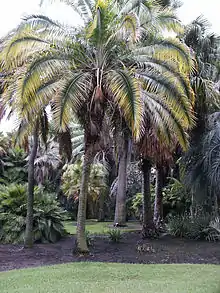Phoenix rupicola
Phoenix rupicola (rupicola - Latin, inhabitant of rocks) or cliff date palm is a species of flowering plant in the palm family, native to the mountainous forests of India and Bhutan from 300 to 1200 m, usually occurring on cliffs, hillsides and similar terrain. It is threatened by habitat loss in its native range. On the other hand, the species is reportedly naturalised in the Andaman Islands, the Leeward Islands, Cuba and Puerto Rico[3] and a specimen has recently been reported in Saint Lucia.
| Phoenix rupicola | |
|---|---|
 | |
| Scientific classification | |
| Kingdom: | Plantae |
| Clade: | Tracheophytes |
| Clade: | Angiosperms |
| Clade: | Monocots |
| Clade: | Commelinids |
| Order: | Arecales |
| Family: | Arecaceae |
| Genus: | Phoenix |
| Species: | P. rupicola |
| Binomial name | |
| Phoenix rupicola | |
Description
Phoenix rupicola palm trees grow to 8 metres (26 ft) in height, and 20 cm in width. They are usually clean of leaf bases except near the crown.
Leaves are 2.5 to 3 m long, 35 cm leaflets, pinnately arranged, on 50 – 60 cm pseudo petioles armed with spines. The spines are much less numerous and less vicious than the other Phoenix species.
The fruit is an oblong, yellow to orange drupe, 2 cm long containing a single large seed.
References
- Johnson, D. 1998. Phoenix rupicola. 2006 IUCN Red List of Threatened Species. Downloaded on 20 July 2007.
- Anderson, Thomas (1869). "An Enumeration of the Palms of Sikkim". Journal of the Linnean Society. Botany. London. 11 (49): 13–14. doi:10.1111/j.1095-8339.1869.tb00048.x.
- Kew World Checklist of Selected Plant Families, Phoenix rupicola
- Riffle, Robert L. and Craft, Paul (2003) An Encyclopedia of Cultivated Palms. Portland: Timber Press. ISBN 0-88192-558-6 / ISBN 978-0-88192-558-6 (Page 405)
